Munson B.R. Fundamentals of Fluid Mechanics
Подождите немного. Документ загружается.

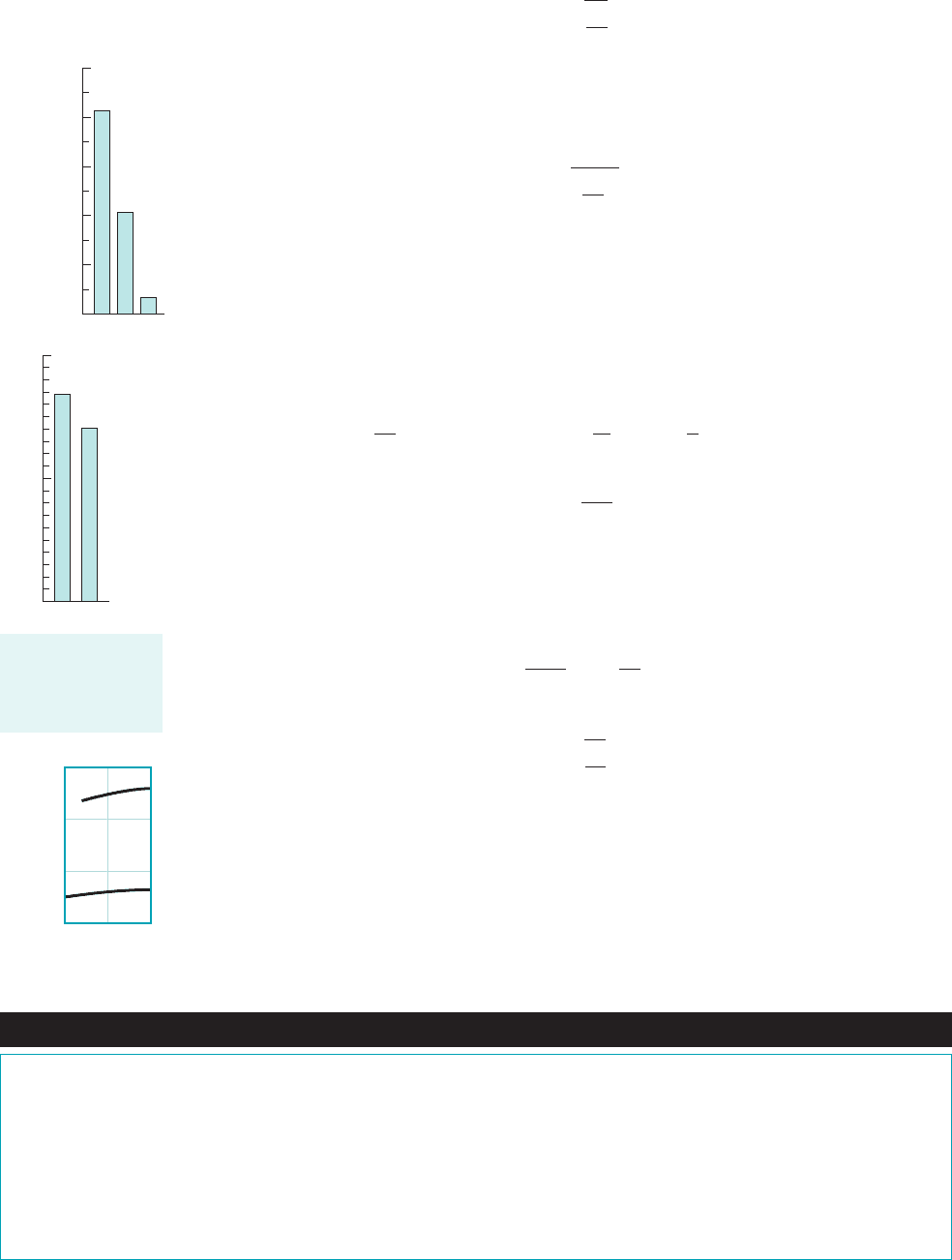
By combining Eqs. 11.28 1continuity2and 11.33 1energy2we again find that
which is identical to Eq. 11.31. Thus, the conservation of linear momentum and the conservation
of energy principles lead to the same result. If we further assume that the frictionless flow through
the control volume of Fig. 11.1b is adiabatic 1no heat transfer2, then the flow is isentropic. In the
limit, as becomes vanishingly small
(11.34)
where the subscript s is used to designate that the partial differentiation occurs at constant entropy.
Equation 11.34 suggests to us that we can calculate the speed of sound by determining the
partial derivative of pressure with respect to density at constant entropy. For the isentropic flow of
an ideal gas 1with constant and 2, we learned earlier 1Eq. 11.252that
and thus
(11.35)
Thus, for an ideal gas
(11.36)
From Eq. 11.36 and the charts in the margin we conclude that for a given temperature, the speed
of sound, c, in hydrogen and in helium, is higher than in air.
More generally, the bulk modulus of elasticity, of any fluid including liquids is defined
as 1see Section 1.7.12
(11.37)
Thus, in general, from Eqs. 11.34 and 11.37,
(11.38)
Values of the speed of sound are tabulated in Tables B.1 and B.2 for water and in
Tables B.3 and B.4 for air. From experience we know that air is more easily compressed than wa-
ter. Note from the values of c in Tables B.1 through B.4 and the graph in the margin that the
speed of sound in air is much less than it is in water. From Eq. 11.37, we can conclude that if a
fluid is truly incompressible, its bulk modulus would be infinitely large, as would be the speed
of sound in that fluid. Thus, an incompressible flow must be considered an idealized approxima-
tion of reality.
c ⫽
B
E
v
r
E
v
⫽
dp
dr
Ⲑ
r
⫽ r a
0p
0r
b
s
E
v
,
c ⫽ 2RTk
a
0p
0r
b
s
⫽ 1constant2 kr
k⫺1
⫽
p
r
k
kr
k⫺1
⫽
p
r
k ⫽ RTk
p ⫽ 1constant21r
k
2
c
v
c
p
c ⫽
B
a
0p
0r
b
s
1dp S0p S 02dp
c ⫽
B
dp
dr
11.2 Mach Number and Speed of Sound 587
5000
4000
3000
Hydrogen
Helium
Air
2000
1000
0
R,
J/kg
⭈
K
2.0
1.0
0
k
Air, hydrogen
Helium
Speed of sound is
larger in fluids that
are more difficult to
compress.
Fluids in the News
Sonification The normal human ear is capable of detecting
even very subtle sound patterns produced by sound waves.
Most of us can distinguish the bark of a dog from the meow of
a cat or the roar of a lion, or identify a person’s voice on the
telephone before they identify who is calling. The number of
“things” we can identify from subtle sound patterns is enor-
mous. Combine this ability with the power of computers to
transform the information from sensor transducers into varia-
tions in pitch, rhythm, and volume and you have sonification,
the representation of data in the form of sound. With this
emerging technology, pathologists may soon learn to “hear”
abnormalities in tissue samples, engineers may “hear” flaws in
gas turbine engine blades being inspected, and scientists may
“hear” a desired attribute in a newly invented material. Perhaps
the concept of hearing the trends in data sets may become as
commonplace as seeing them. Analysts may listen to the stock
market and make decisions. Of course, none of this can happen
in a vacuum.
6000
4000
Water
Air
2000
0 100 200
0
c, ft/s
T, deg F
JWCL068_ch11_579-644.qxd 9/25/08 8:17 PM Page 587
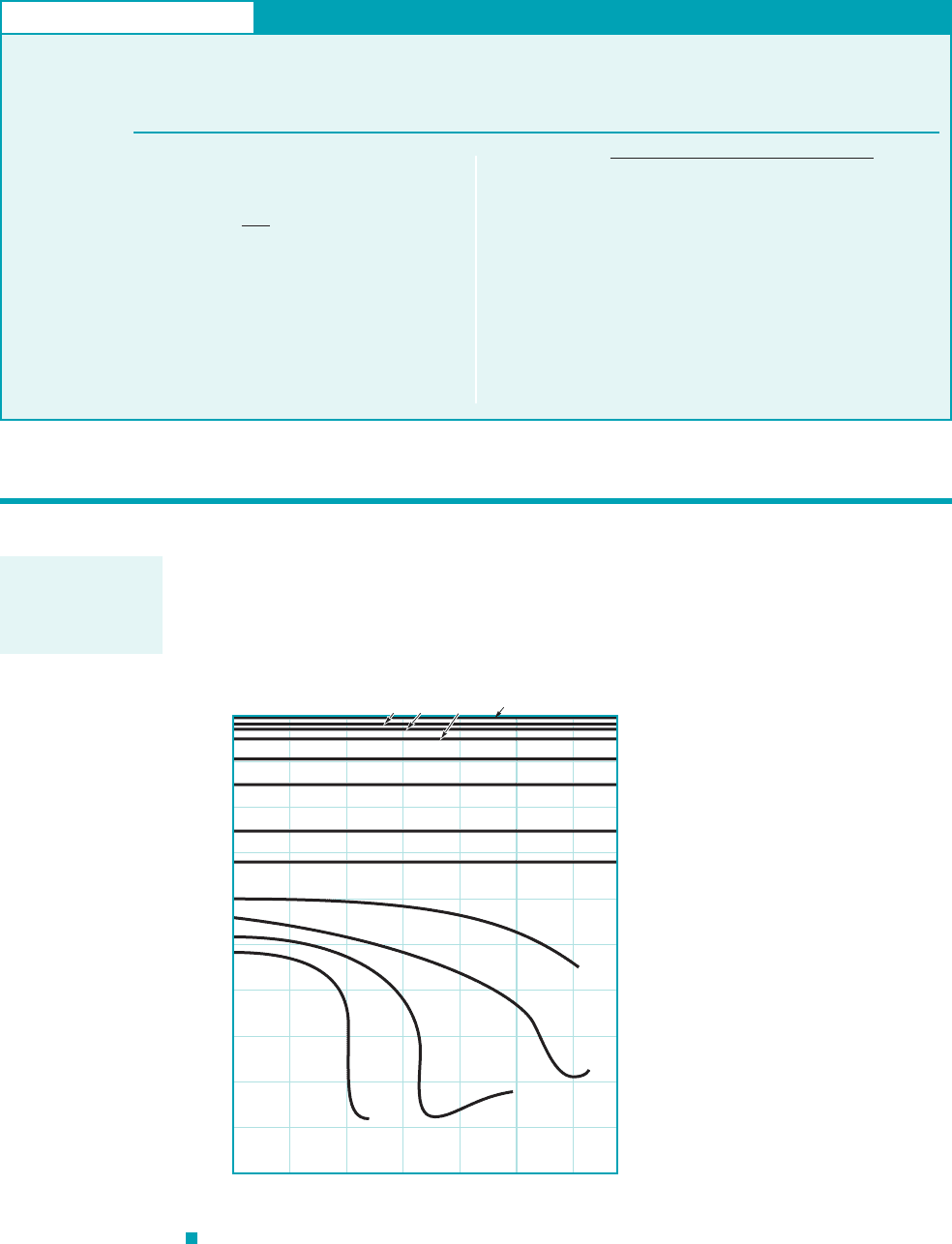
588 Chapter 11 ■ Compressible Flow
GIVEN Consider the data in Table B.4.
FIND Verify the speed of sound for air at .0 °C
S
OLUTION
Speed of Sound
Thus, since
we obtain
(Ans)
COMMENT The value of the speed of sound calculated with
Eq. 11.36 agrees very well with the value of c listed in Table B.4.
The ideal gas approximation does not compromise this result sig-
nificantly.
c ⫽ 331.4 m
Ⲑ
s
1 1m
Ⲑ
s2
2
,
1 J
Ⲑ
kg ⫽ 1 N
#
m
Ⲑ
kg ⫽ 1 1kg
#
m
Ⲑ
s
2
2
#
m
Ⲑ
kg ⫽
⫽ 331.4 1J
Ⲑ
kg2
1
Ⲑ
2
c ⫽ 231286.92 J
Ⲑ
1kg
#
K241273.15 K211.4012
E
XAMPLE 11.3
In Table B.4, we find the speed of sound of air at given as
331.4 m兾s. Assuming that air behaves as an ideal gas, we can cal-
culate the speed of sound from Eq. 11.36 as
(1)
The value of the gas constant is obtained from Table 1.8 as
and the specific heat ratio is listed in Table B.4 as
By substituting values of R, k, and T into Eq. 1 we obtain
k ⫽ 1.401
R ⫽ 286.9 J
Ⲑ
1kg
#
K2
c ⫽ 2RTk
0 °C
In Section 3.8.1, we learned that the effects of compressibility become more significant as the Mach
number increases. For example, the error associated with using in calculating the stagna-
tion pressure of an ideal gas increases at larger Mach numbers. From Fig. 3.24 we can conclude
that incompressible flows can only occur at low Mach numbers.
Experience has also demonstrated that compressibility can have a large influence on other
important flow variables. For example, in Fig. 11.2 the variation of drag coefficient with Reynolds
rV
2
Ⲑ
2
11.3 Categories of Compressible Flow
F I G U R E 11.2 The variation of the drag coeffi-
cient of a sphere with Reynolds number and Mach number.
(Adapted from Fig. 1.8 in Ref. 1 of Chapter 9.)
0.3
0.5
0.6
0.7
0.9
1.0
1.1
4.5
3.0 1.52.0Ma = 1.2
1.0
0.9
0.8
0.7
0.6
0.5
0.4
0.3
0.2
0.1
0
C
D
23456789
Re × 10
–5
Compressibility ef-
fects are more im-
portant at higher
Mach numbers.
JWCL068_ch11_579-644.qxd 9/25/08 8:17 PM Page 588
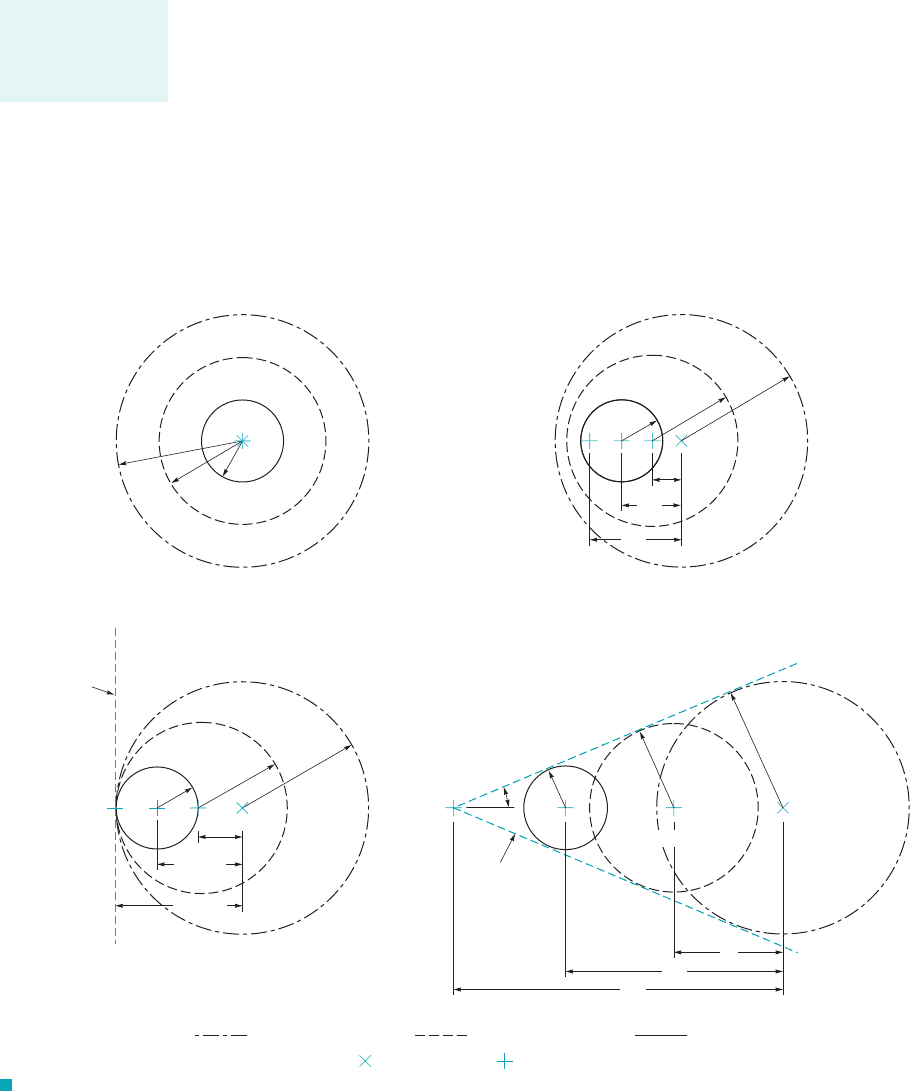
number and Mach number is shown for air flow over a sphere. Compressibility effects can be of
considerable importance.
To further illustrate some curious features of compressible flow, a simplified example is con-
sidered. Imagine the emission of weak pressure pulses from a point source. These pressure waves
are spherical and expand radially outward from the point source at the speed of sound, c. If a pres-
sure wave is emitted at different times, we can determine where several waves will be at a
common instant of time, t, by using the relationship
where r is the radius of the sphere-shaped wave emitted at time For a stationary point
source, the symmetrical wave pattern shown in Fig. 11.3a is involved.
When the point source moves to the left with a constant velocity, V, the wave pattern is no
longer symmetrical. In Figs. 11.3b, 11.3c, and 11.3d are illustrated the wave patterns at s for
different values of Also shown with a “ ” are the positions of the moving point source at val-
ues of time, t, equal to 0 s, 1 s, 2 s, and 3 s. Knowing where the point source has been at differ-
ent instances is important because it indicates to us where the different waves originated.
From the pressure wave patterns of Fig. 11.3, we can draw some useful conclusions. Before
doing this we should recognize that if instead of moving the point source to the left, we held the
point source stationary and moved the fluid to the right with velocity V, the resulting pressure wave
patterns would be identical to those indicated in Fig. 11.3.
⫹V.
t ⫽ 3
⫽ t
wave
.
r ⫽ 1t ⫺ t
wave
2c
t
wave
,
11.3 Categories of Compressible Flow 589
3c
2c
c
(a)
(b)
c
2c
3V
2V
V
3c
(c)
c
2c
3c
Zone of actionZone of silence
Tangent plane
(Mach wave)
V = c
2V = 2c
3V = 3c
(d)
c
2c
3V
2V
V
3c
α
Zone of silence
Mach cone
Zone of action
Wave emitted at
t = 0 s Wave emitted at t = 1 s Wave emitted at t = 2 s
Source at t = 1, 2, or 3 sSource at t = 0 s
F I G U R E 11.3 (a) Pressure waves at (b) pressure waves at t 3 s,t 3 s, V 0;
(c) pressure waves at (d) pressure waves at V 7 c.t 3 s,V c;t 3 s,V 6 c;
The wave pattern
from a moving
source is not
symmetrical.
JWCL068_ch11_579-644.qxd 9/25/08 8:17 PM Page 589
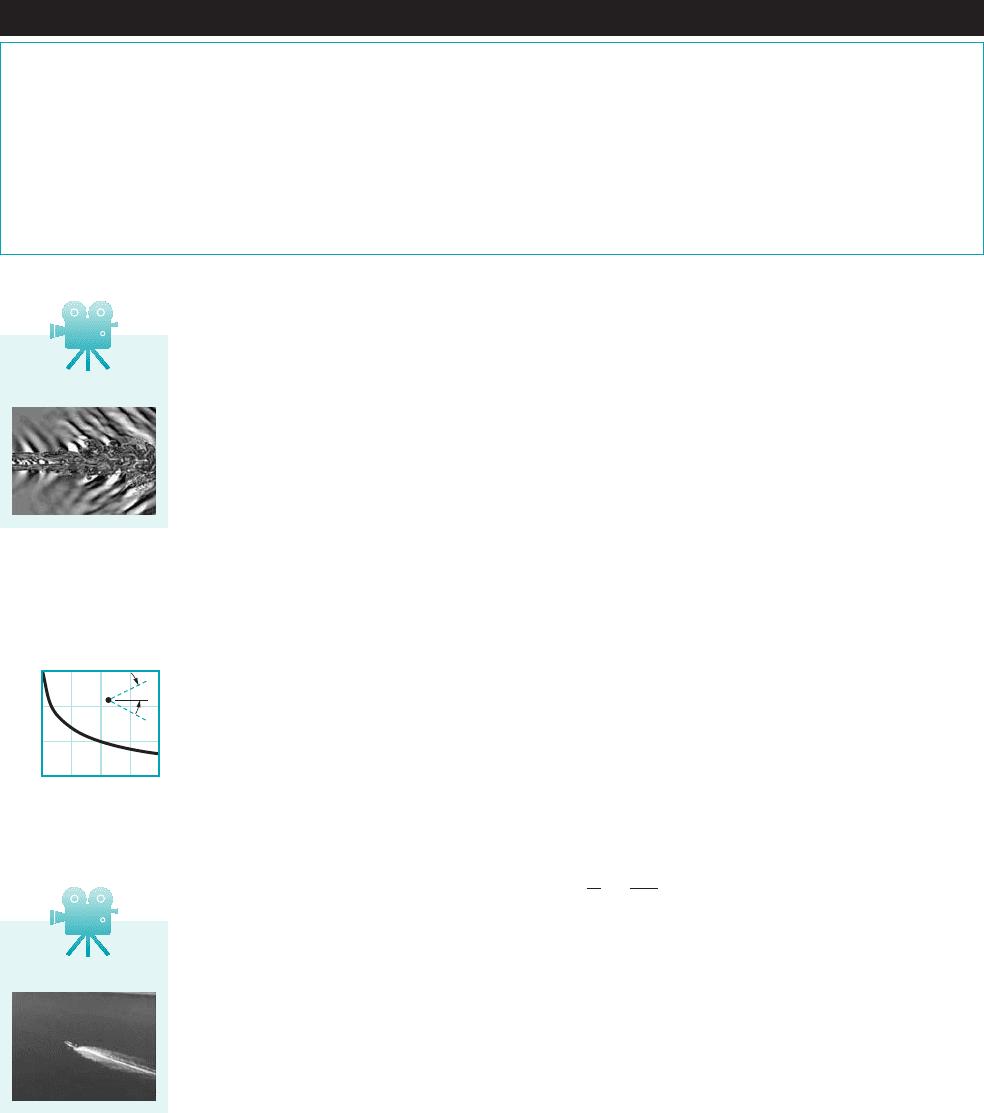
When the point source moves in fluid at rest 1or when fluid moves past a stationary point
source2, the pressure wave patterns vary in asymmetry, with the extent of asymmetry depending
on the ratio of the point source 1or fluid2velocity and the speed of sound. When the wave
pattern is similar to the one shown in Fig. 11.3b. This flow is considered subsonic and compress-
ible. A stationary observer will hear a different sound frequency coming from the point source de-
pending on where the observer is relative to the source because the wave pattern is asymmetrical.
We call this phenomenon the Doppler effect. Pressure information can still travel unrestricted
throughout the flow field, but not symmetrically or instantaneously.
When pressure waves are not present ahead of the moving point source. The flow
is sonic. If you were positioned to the left of the moving point source, you would not hear the
point source until it was coincident with your location. For flow moving past a stationary point
source at the speed of sound the pressure waves are all tangent to a plane that is per-
pendicular to the flow and that passes through the point source. The concentration of pressure
waves in this tangent plane suggests the formation of a significant pressure variation across the
plane. This plane is often called a Mach wave. Note that communication of pressure information
is restricted to the region of flow downstream of the Mach wave. The region of flow upstream of
the Mach wave is called the zone of silence and the region of flow downstream of the tangent plane
is called the zone of action.
When the flow is supersonic and the pressure wave pattern resembles the one de-
picted in Fig. 11.3d. A cone 1Mach cone2that is tangent to the pressure waves can be con-
structed to represent the Mach wave that separates the zone of silence from the zone of action
in this case. The communication of pressure information is restricted to the zone of action.
From the sketch of Fig. 11.3d, we can see that the angle of this cone, is given by
(11.39)
This relationship between Mach number, Ma, and Mach cone angle, , shown by the figure in
the margin, is valid for only. The concentration of pressure waves at the surface of
the Mach cone suggests a significant pressure, and thus density, variation across the cone sur-
face. (See the photograph at the beginning of this chapter.) An abrupt density change can be
visualized in a flow field by using special optics. Examples of flow visualization methods in-
clude the schlieren, shadowgraph, and interferometer techniques 1see Ref. 42. A schlieren photo
of a flow for which is shown in Fig. 11.4. The air flow through the row of compressor
blade airfoils is as shown with the arrow. The flow enters supersonically and1Ma
1
⫽ 1.142
V 7 c
V
Ⲑ
c 7 1
a
sin a ⫽
c
V
⫽
1
Ma
a,
V 7 c,
1V
Ⲑ
c ⫽ 12,
V
Ⲑ
c ⫽ 1,
V
Ⲑ
c 6 1,
590 Chapter 11 ■ Compressible Flow
1 1.5 2
Ma
2.5 3
90
60
a
a
30
0
V11.3 Speed boat
Fluids in the News
Pistol shrimp confound blast detectorsAuthorities are on the
trail of fishermen in Southeast Asia and along Africa’s east
coast who illegally blast coral reefs to rubble to increase their
catch. Researchers at Hong Kong University of Science and
Technology have developed a method of using underwater mi-
crophones (hydrophones) to pick up the noise from such blasts.
One complicating factor in the development of such a system is
the noise produced by the claw-clicking pistol shrimp that live
on the reefs. The third right appendage of the 2-in.-long pistol
shrimp is adapted into a huge claw with a moveable finger that
can be snapped shut with so much force that the resulting sound
waves kill or stun nearby prey. When near the hydrophones, the
shrimp can generate short-range shock waves that are bigger
than the signal from a distant blast. By recognizing the differ-
ences between the signatures of the sound from an explosion
and that of the pistol shrimp “blast,” the scientists can differen-
tiate between the two and pinpoint the location of the illegal
blasts.
V11.2 Jet noise
When the point source and the fluid are stationary, the pressure wave pattern is symmetrical
1Fig. 11.3a2and an observer anywhere in the pressure field would hear the same sound frequency
from the point source. When the velocity of the point source 1or the fluid2is very small in com-
parison with the speed of sound, the pressure wave pattern will still be nearly symmetrical. The
speed of sound in an incompressible fluid is infinitely large. Thus, the stationary point source and
stationary fluid situation are representative of incompressible flows. For truly incompressible flows,
the communication of pressure information throughout the flow field is unrestricted and instanta-
neous 1c ⫽⬁2.
JWCL068_ch11_579-644.qxd 9/25/08 8:17 PM Page 590
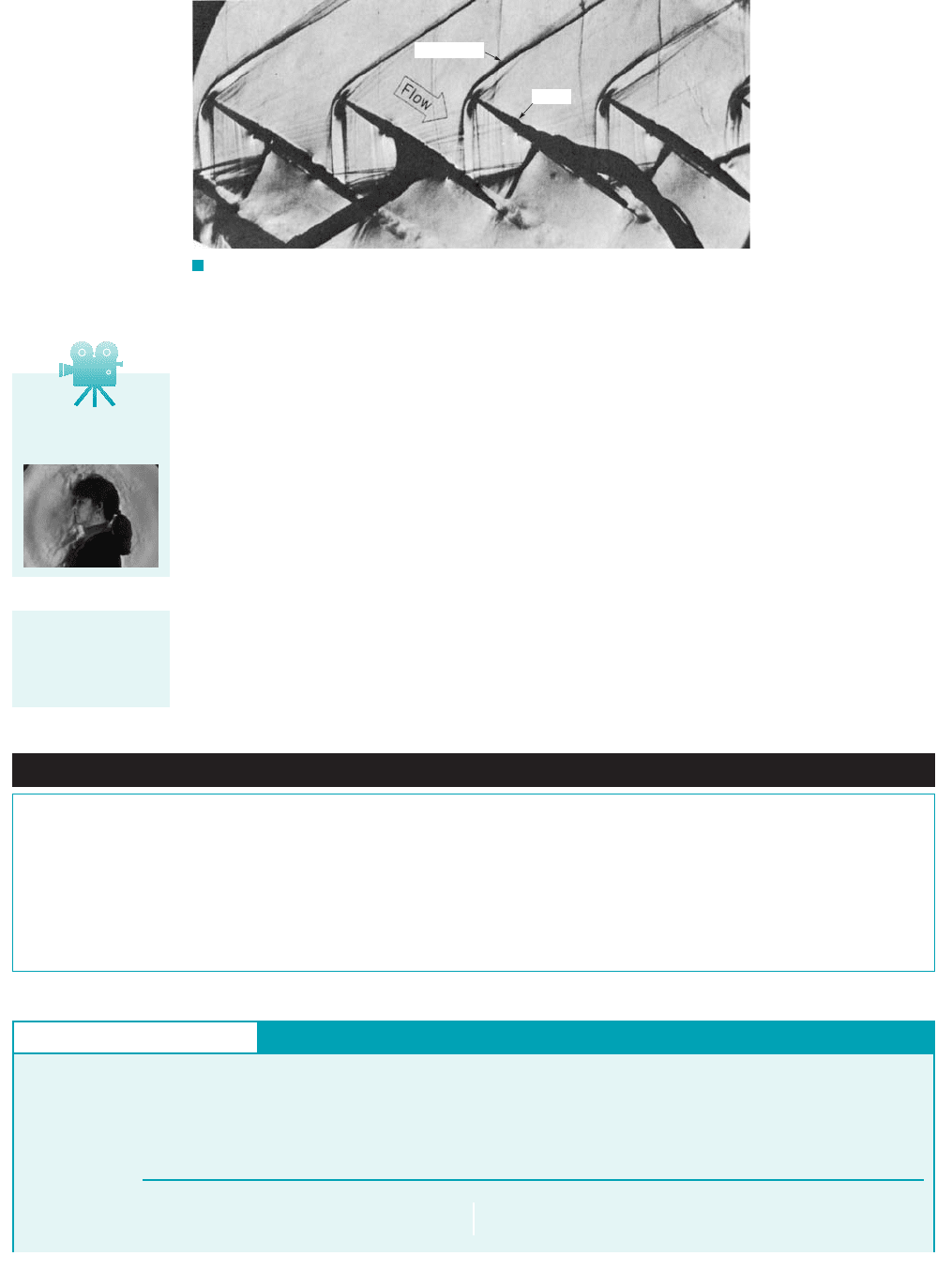
leaves subsonically . The center two airfoils have pressure tap hoses connected to
them. Regions of significant changes in fluid density appear in the supersonic portion of the
flow. Also, the region of separated flow on each airfoil is visible.
This discussion about pressure wave patterns suggests the following categories of fluid flow:
1. Incompressible flow: Unrestricted, nearly symmetrical and instantaneous pressure
communication.
2. Compressible subsonic flow: Unrestricted but noticeably asymmetrical
pressure communication.
3. Compressible supersonic flow: Formation of Mach wave; pressure communica-
tion restricted to zone of action.
In addition to the above-mentioned categories of flows, two other regimes are commonly referred
to: namely, transonic flows and hypersonic flows Modern aircraft
are mainly powered by gas turbine engines that involve transonic flows. When a space shuttle reen-
ters the earth’s atmosphere, the flow is hypersonic. Future aircraft may be expected to operate from
subsonic to hypersonic flow conditions.
1Ma 7 52.10.9 ⱕ Ma ⱕ 1.22
Ma ⱖ 1.0.
0.3 6 Ma 6 1.0.
Ma ⱕ 0.3.
1Ma
2
⫽ 0.862
11.3 Categories of Compressible Flow 591
F I G U R E 11.4 The Schlieren visualization of flow (supersonic to
subsonic) through a row of compressor airfoils. (Photograph provided by Dr. Hans
Starken, Germany.)
Shock wave
Airfoil
V11.4 Compressible
flow visualization
Abrupt changes in
fluid properties can
occur in supersonic
flows.
Fluids in the News
Supersonic and compressible flows in gas turbines Modern
gas turbine engines commonly involve compressor and turbine
blades that are moving so fast that the fluid flows over the blades
are locally supersonic. Density varies considerably in these
flows so they are also considered to be compressible. Shock
waves can form when these supersonic flows are sufficiently de-
celerated. Shocks formed at blade leading edges or on blade sur-
faces can interact with other blades and shocks and seriously
affect blade aerodynamic and structural performance. It is possi-
ble to have supersonic flows past blades near the outer diameter
of a rotor with subsonic flows near the inner diameter of the same
rotor. These rotors are considered to be transonic in their opera-
tion. Very large aero gas turbines can involve thrust levels ex-
ceeding 100,000 lb. Two of these engines are sufficient to carry
over 350 passengers halfway around the world at high subsonic
speed. (See Problem 11.81.)
GIVEN An aircraft cruising at 1000-m elevation, z, above you
moves past in a flyby. It is moving with a Mach number equal to
1.5 and the ambient temperature is .20 °C
FIND How many seconds after the plane passes overhead do
you expect to wait before you hear the aircraft?
Mach Cone
E
XAMPLE 11.4
S
OLUTION
as is illustrated in Fig. E11.4a. A photograph of this phenomenon
is shown in Fig. E11.4b. When the surface of the cone reaches the
Since the aircraft is moving supersonically we can
imagine a Mach cone originating from the forward tip of the craft
1Ma 7 12,
JWCL068_ch11_579-644.qxd 9/25/08 8:17 PM Page 591
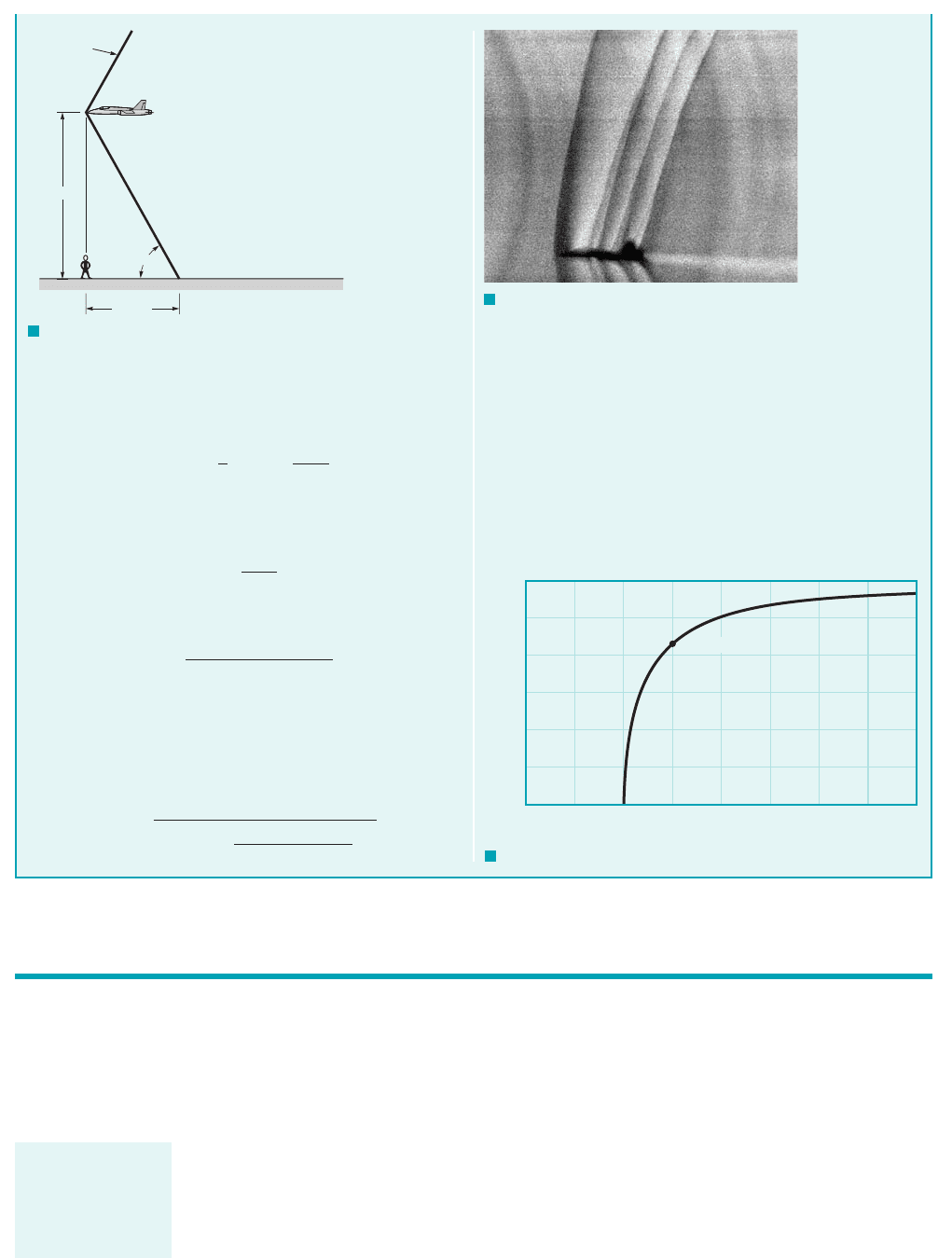
592 Chapter 11 ■ Compressible Flow
observer, the “sound” of the aircraft is perceived. The angle in
Fig. E11.4 is related to the elevation of the plane, z, and the ground
distance, x,by
(1)
Also, assuming negligible change of Mach number with elevation,
we can use Eq. 11.39 to relate Mach number to the angle Thus,
(2)
Combining Eqs. 1 and 2 we obtain
(3)
The speed of the aircraft can be related to the Mach number with
(4)
where c is the speed of sound. From Table B.4,
Using we get from Eqs. 3 and 4
1.5 ⫽
1
sinetan
⫺1
c
1000 m
11.521343.3 m
Ⲑ
s2t
df
Ma ⫽ 1.5,
c ⫽ 343.3 m
Ⲑ
s.
V ⫽ 1Ma2c
Ma ⫽
1
sin 3tan
⫺1
11000
Ⲑ
Vt24
Ma ⫽
1
sin a
a.
a ⫽ tan
⫺1
z
x
⫽ tan
⫺1
1000
Vt
a
or
(Ans)
COMMENT By repeating the calculations for various values
of Mach number, Ma, the results shown in Fig. E11.4c are ob-
tained. Note that for subsonic flight (Ma ⬍ 1) there is no delay
since the sound travels faster than the aircraft. You can hear a sub-
sonic aircraft approaching.
t ⫽ 2.17 s
F I G U R E E11.4
a
F I G U R E E11.4
b
NASA
Schlieren photograph of shock waves from a
T-38 aircraft at Mach 1.1, 13,000 feet.
z
Mach cone
Aircraft moving with velocity
V and Mach number Ma
α
x = Vt
F I G U R E E11.4
c
(1.5, 2.17 s)
3
2.5
2
1.5
1
0.5
0
0 0.5 1 1.5 2
Ma
2.5 3 3.5 4
t, s
In this section, we consider in further detail the steady, one-dimensional, isentropic flow of an ideal
gas with constant specific heat values 1 and 2. Because the flow is steady throughout, shaft work
cannot be involved. Also, as explained earlier, the one-dimensionality of flows we discuss in this
chapter implies velocity and fluid property changes in the streamwise direction only. We consider
flows through finite control volumes with uniformly distributed velocities and fluid properties at
each section of flow. Much of what we develop can also apply to the flow of a fluid particle along
its pathline.
Isentropic flow involves constant entropy and was discussed earlier in Section 11.1, where
we learned that adiabatic and frictionless 1reversible2flow is one form of isentropic flow. Some
ideal gas relationships for isentropic flows were developed in Section 11.1. An isentropic flow is
not achievable with actual fluids because of friction. Nonetheless, the study of isentropic flow
trends is useful because it helps us to gain an understanding of actual compressible flow phenomena
c
v
c
p
11.4 Isentropic Flow of an Ideal Gas
An important class
of isentropic flow
involves no heat
transfer and zero
friction.
JWCL068_ch11_579-644.qxd 9/25/08 8:17 PM Page 592

including choked flow, shock waves, acceleration from subsonic to supersonic flow, and deceler-
ation from supersonic to subsonic flow.
11.4.1 Effect of Variations in Flow Cross-Sectional Area
When fluid flows steadily through a conduit that has a flow cross-sectional area that varies with
axial distance, the conservation of mass 1continuity2equation
(11.40)
can be used to relate the flow rates at different sections. For incompressible flow, the fluid density
remains constant and the flow velocity from section to section varies inversely with cross-sectional
area. However, when the flow is compressible, density, cross-sectional area, and flow velocity can
all vary from section to section. We proceed to determine how fluid density and flow velocity
change with axial location in a variable area duct when the fluid is an ideal gas and the flow through
the duct is steady and isentropic.
In Chapter 3, Newton’s second law was applied to the inviscid 1frictionless2and steady flow
of a fluid particle. For the streamwise direction, the result 1Eq. 3.52for either compressible or in-
compressible flows is
(11.41)
The frictionless flow from section to section through a finite control volume is also governed by Eq.
11.41, if the flow is one-dimensional, because every particle of fluid involved will have the same ex-
perience. For ideal gas flow, the potential energy difference term, can be dropped because of
its small size in comparison to the other terms, namely, dp and Thus, an appropriate equation
of motion in the streamwise direction for the steady, one-dimensional, and isentropic 1adiabatic and
frictionless2flow of an ideal gas is obtained from Eq. 11.41 as
(11.42)
If we form the logarithm of both sides of the continuity equation 1Eq. 11.402, the result is
(11.43)
Differentiating Eq. 11.43 we get
or
(11.44)
Now we combine Eqs. 11.42 and 11.44 to obtain
(11.45)
Since the flow being considered is isentropic, the speed of sound is related to variations of
pressure with density by Eq. 11.34, repeated here for convenience as
Equation 11.34, combined with the definition of Mach number
(11.46)
and Eq. 11.45 yields
(11.47)
dp
rV
2
11 ⫺ Ma
2
2⫽
dA
A
Ma ⫽
V
c
c ⫽
B
a
0p
0r
b
s
dp
rV
2
a1 ⫺
V
2
dp
Ⲑ
dr
b⫽
dA
A
⫺
dV
V
⫽
dr
r
⫹
dA
A
dr
r
⫹
dA
A
⫹
dV
V
⫽ 0
ln r ⫹ ln A ⫹ ln V ⫽ constant
dp
rV
2
⫽⫺
dV
V
d1V
2
2.
g dz,
dp ⫹
1
2
r d1V
2
2⫹ g
dz ⫽ 0
m
#
⫽ rAV ⫽ constant
11.4 Isentropic Flow of an Ideal Gas 593
Density, cross-
sectional area, and
velocity may all
vary for a com-
pressible flow.
JWCL068_ch11_579-644.qxd 9/25/08 8:17 PM Page 593
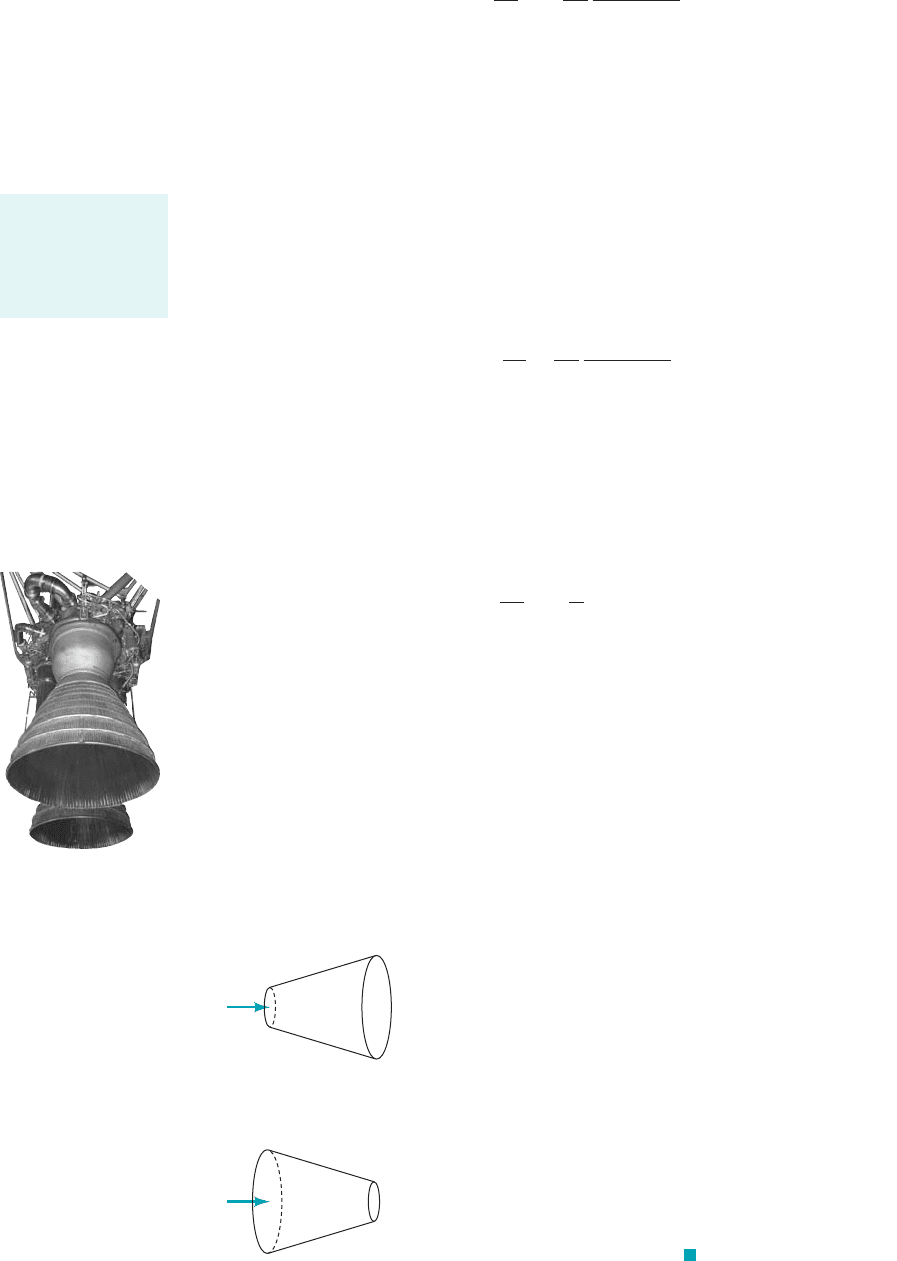
Equations 11.42 and 11.47 merge to form
(11.48)
We can use Eq. 11.48 to conclude that when the flow is subsonic velocity and
section area changes are in opposite directions. In other words, the area increase associated with
subsonic flow through a diverging duct like the one shown in Fig. 11.5a is accompanied by a ve-
locity decrease. Subsonic flow through a converging duct 1see Fig. 11.5b2involves an increase of
velocity. These trends are consistent with incompressible flow behavior, which we described ear-
lier in this book, for instance, in Chapters 3 and 8.
Equation 11.48 also serves to show us that when the flow is supersonic velocity
and area changes are in the same direction. A diverging duct 1Fig. 11.5a2will accelerate a super-
sonic flow. A converging duct 1Fig. 11.5b2will decelerate a supersonic flow. These trends are the
opposite of what happens for incompressible and subsonic compressible flows.
To better understand why subsonic and supersonic duct flows are so different, we combine
Eqs. 11.44 and 11.48 to form
(11.49)
Using Eq. 11.49, we can conclude that for subsonic flows density and area changes are
in the same direction, whereas for supersonic flows density and area changes are in op-
posite directions. Since must remain constant 1Eq. 11.402, when the duct diverges and the flow
is subsonic, density and area both increase and thus flow velocity must decrease. However, for su-
personic flow through a diverging duct, when the area increases, the density decreases enough so
that the flow velocity has to increase to keep constant.
By rearranging Eq. 11.48, we can obtain
(11.50)
Equation 11.50 gives us some insight into what happens when For Eq. 11.50
requires that This result suggests that the area associated with is either a min-
imum or a maximum amount.
A converging–diverging duct 1Fig. 11.6a and margin photograph2involves a minimum area.
If the flow entering such a duct were subsonic, Eq. 11.48 discloses that the fluid velocity would
increase in the converging portion of the duct, and achievement of a sonic condition at
the minimum area location appears possible. If the flow entering the converging–diverging duct
is supersonic, Eq. 11.48 states that the fluid velocity would decrease in the converging portion of
the duct and the sonic condition at the minimum area is possible.
1Ma ⫽ 12
Ma ⫽ 1dA
Ⲑ
dV ⫽ 0.
Ma ⫽ 1,Ma ⫽ 1.
dA
dV
⫽⫺
A
V
11 ⫺ Ma
2
2
rAV
rAV
1Ma 7 12,
1Ma 6 12,
dr
r
⫽
dA
A
Ma
2
11 ⫺ Ma
2
2
1Ma 7 12,
1Ma 6 12,
dV
V
⫽⫺
dA
A
1
11 ⫺ Ma
2
2
594 Chapter 11 ■ Compressible Flow
Flow
Flow
Subsonic flow
(Ma < 1)
dA > 0
dV < 0
Supersonic flow
(Ma > 1)
dA > 0
dV > 0
dA < 0
dV > 0
dA < 0
dV < 0
(
a)
(
b)
F I G U R E 11.5 (a) A
diverging duct. (b) A converging duct.
A converging duct
will decelerate a su-
personic flow and
accelerate a sub-
sonic flow.
JWCL068_ch11_579-644.qxd 9/25/08 8:17 PM Page 594

A diverging–converging duct 1Fig. 11.6b2, on the other hand, would involve a maximum area.
If the flow entering this duct were subsonic, the fluid velocity would decrease in the diverging por-
tion of the duct and the sonic condition could not be attained at the maximum area location. For
supersonic flow in the diverging portion of the duct, the fluid velocity would increase and thus
at the maximum area is again impossible.
For the steady isentropic flow of an ideal gas, we conclude that the sonic condition
can be attained in a converging–diverging duct at the minimum area location. This minimum area
location is often called the throat of the converging–diverging duct. Furthermore, to achieve super-
sonic flow from a subsonic state in a duct, a converging–diverging area variation is necessary. For
this reason, we often refer to such a duct as a converging–diverging nozzle. Note that a converging–
diverging duct can also decelerate a supersonic flow to subsonic conditions. Thus, a converging–
diverging duct can be a nozzle or a diffuser depending on whether the flow in the converging portion
of the duct is subsonic or supersonic. A supersonic wind tunnel test section is generally preceded by
a converging–diverging nozzle and followed by a converging–diverging diffuser 1see Ref. 12. Fur-
ther details about steady, isentropic, ideal gas flow through a converging–diverging duct are discussed
in the next section.
11.4.2 Converging–Diverging Duct Flow
In the preceding section, we discussed the variation of density and velocity of the steady isentropic
flow of an ideal gas through a variable area duct. We proceed now to develop equations that help
us determine how other important flow properties vary in these flows.
It is convenient to use the stagnation state of the fluid as a reference state for compressible flow
calculations. The stagnation state is associated with zero flow velocity and an entropy value that cor-
responds to the entropy of the flowing fluid. The subscript 0 is used to designate the stagnation state.
Thus, stagnation temperature and pressure are and For example, if the fluid flowing through
the converging–diverging duct of Fig. 11.6a were drawn isentropically from the atmosphere, the at-
mospheric pressure and temperature would represent the stagnation state of the flowing fluid. The
stagnation state can also be achieved by isentropically decelerating a flow to zero velocity. This can
be accomplished with a diverging duct for subsonic flows or a converging–diverging duct for super-
sonic flows. Also, as discussed earlier in Chapter 3, an approximately isentropic deceleration can be
accomplished with a Pitot-static tube 1see Fig. 3.62. It is thus possible to measure, with only a small
amount of uncertainty, values of stagnation pressure, and stagnation temperature, of a flow-
ing fluid.
In Section 11.1, we demonstrated that for the isentropic flow of an ideal gas 1see Eq. 11.252
The streamwise equation of motion for steady and frictionless flow 1Eq. 11.412can be expressed
for an ideal gas as
(11.51)
since the potential energy term, , can be considered as being negligibly small in comparison
with the other terms involved.
g dz
dp
r
⫹ d a
V
2
2
b⫽ 0
p
r
k
⫽ constant ⫽
p
0
r
k
0
T
0
,p
0
,
p
0
.T
0
1Ma ⫽ 12
Ma ⫽ 1
11.4 Isentropic Flow of an Ideal Gas 595
A converging–
diverging duct is re-
quired to accelerate
a flow from sub-
sonic to supersonic
flow conditions.
(a)(b)
Flow
Flow
F I G U R E 11.6 (a) A converging–diverging duct. (b) A diverging–
converging duct.
JWCL068_ch11_579-644.qxd 9/25/08 8:17 PM Page 595
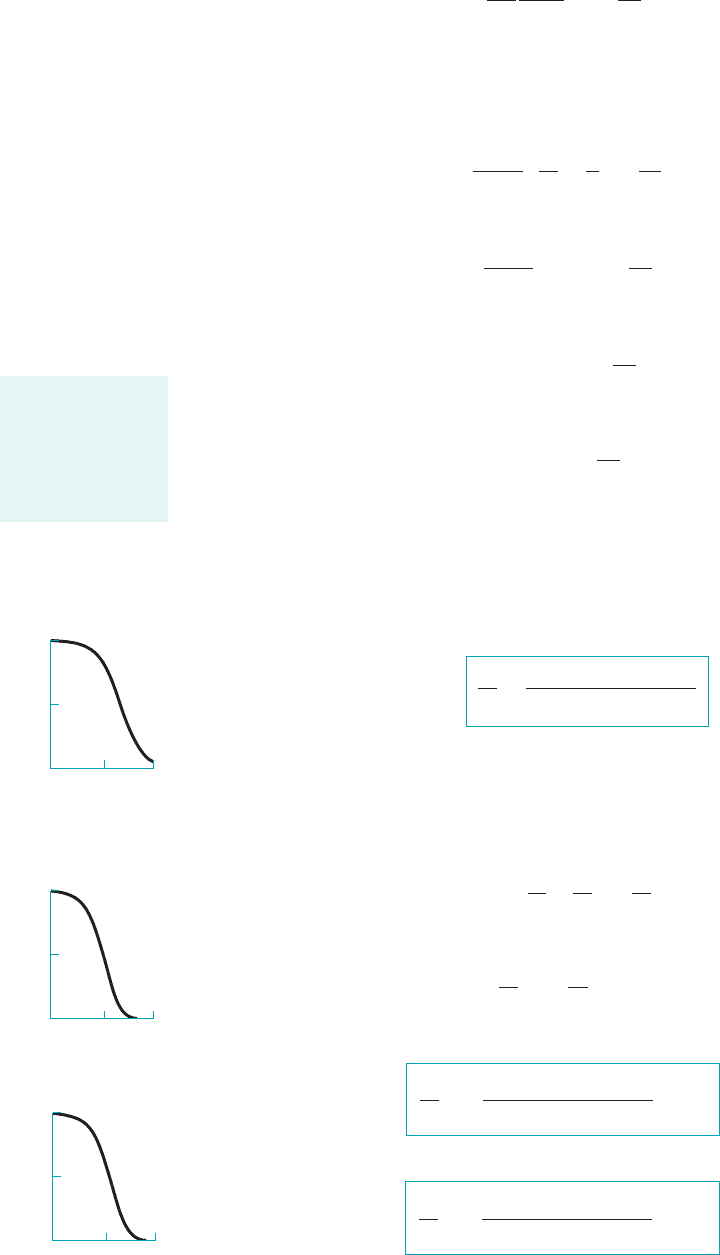
By incorporating Eq. 11.25 into Eq. 11.51 we obtain
(11.52)
Consider the steady, one-dimensional, isentropic flow of an ideal gas with constant and
through the converging–diverging nozzle of Fig. 11.6a. Equation 11.52 is valid for this flow
and can be integrated between the common stagnation state of the flowing fluid to the state of the
gas at any location in the converging–diverging duct to give
(11.53)
By using the ideal gas equation of state 1Eq. 11.12with Eq. 11.53 we obtain
(11.54)
It is of interest to note that combining Eqs. 11.14 and 11.54 leads to
which, when merged with Eq. 11.9, results in
(11.55)
where is the stagnation enthalpy. If the steady flow energy equation 1Eq. 5.692is applied to the
flow situation we are presently considering, the resulting equation will be identical to Eq. 11.55.
Further, we conclude that the stagnation enthalpy is constant. The conservation of momentum and
energy principles lead to the same equation 1Eq. 11.552for steady isentropic flows.
The definition of Mach number 1Eq. 11.462and the speed of sound relationship for ideal
gases (Eq. 11.36) can be combined with Eq. 11.54 to yield
(11.56)
which is graphed in the margin for air. With Eq. 11.56 we can calculate the temperature of an
ideal gas anywhere in the converging–diverging duct of Fig. 11.6a if the flow is steady, one-
dimensional, and isentropic, provided we know the value of the local Mach number and the stag-
nation temperature.
We can also develop an equation for pressure variation. Since then
(11.57)
From Eqs. 11.57 and 11.25 we obtain
(11.58)
Combining Eqs. 11.58 and 11.56 leads to
(11.59)
For density variation we consolidate Eqs. 11.56, 11.57, and 11.59 to get
(11.60)
These relationships are graphed in the margin for air.
r
r
0
⫽ e
1
1 ⫹ 31k ⫺ 12
Ⲑ
24Ma
2
f
1
Ⲑ
1k⫺12
p
p
0
⫽ e
1
1 ⫹ 31k ⫺ 12
Ⲑ
24Ma
2
f
k
Ⲑ
1k⫺12
a
p
p
0
b⫽ a
T
T
0
b
k
Ⲑ
1k⫺12
a
p
p
0
b a
r
0
r
b⫽
T
T
0
p
Ⲑ
r ⫽ RT,
T
T
0
⫽
1
1 ⫹ 31k ⫺ 12
Ⲑ
24Ma
2
h
ˇ
0
h
ˇ
0
⫺ ah
ˇ
⫹
V
2
2
b⫽ 0
c
p
1T
0
⫺T2 ⫺
V
2
2
⫽ 0
kR
k ⫺ 1
1T
0
⫺T2 ⫺
V
2
2
⫽ 0
k
k ⫺ 1
a
p
0
r
0
⫺
p
r
b⫺
V
2
2
⫽ 0
c
v
c
p
p
1
Ⲑ
k
0
r
0
dp
1p2
1
Ⲑ
k
⫹ d a
V
2
2
b⫽ 0
596 Chapter 11 ■ Compressible Flow
10
5.0
0.0
101.0
Ma
0.1
T
__
T
0
1.0
0.5
0.0
10.01.0
Ma
0.1
p
__
p
0
1.0
0.5
0.0
10.01.0
Ma
0.1
__
0
ρ
ρ
For isentropic flows
the temperature,
pressure, and den-
sity ratios are func-
tions of the Mach
number.
JWCL068_ch11_579-644.qxd 9/25/08 8:18 PM Page 596
